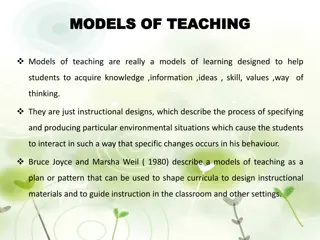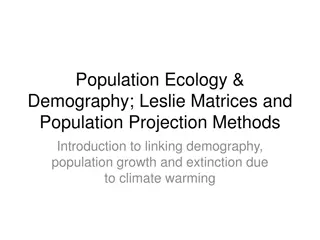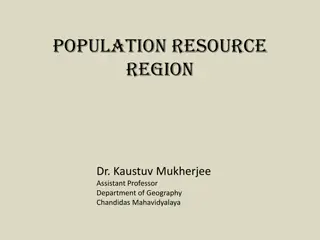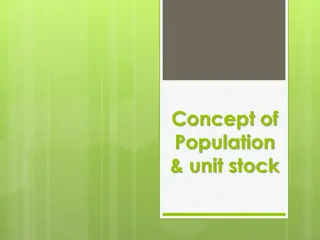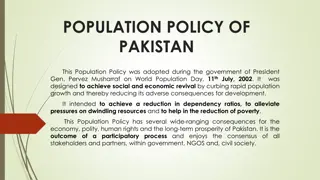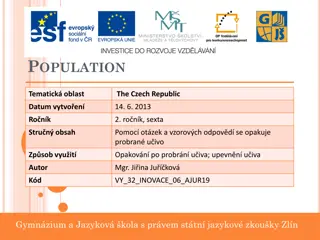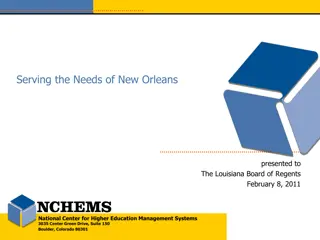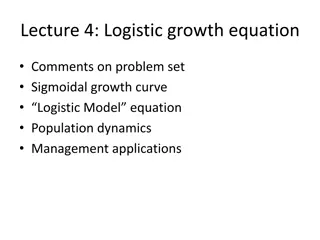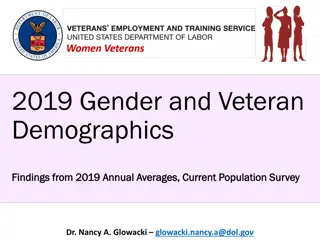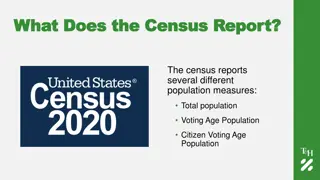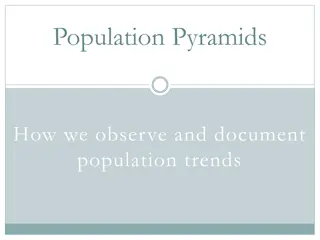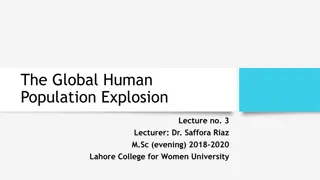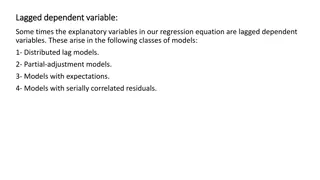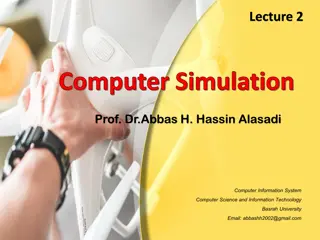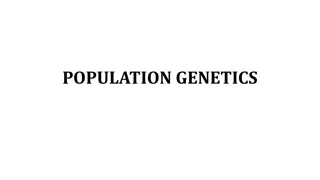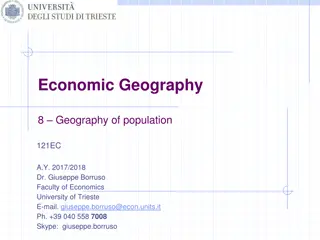Overview of the South African National Population Register
The South African National Population Register (NPR) is a vital system maintained by the Department of Home Affairs. It serves to record and update information on the country's resident population, issue identity documents, and handle related administrative tasks. The NPR has evolved over the years
4 views • 16 slides
System Models in Software Engineering: A Comprehensive Overview
System models play a crucial role in software engineering, aiding in understanding system functionality and communicating with customers. They include context models, behavioural models, data models, object models, and more, each offering unique perspectives on the system. Different types of system
7 views • 33 slides
Models of Teaching for Effective Learning
Models of teaching serve as instructional designs to facilitate students in acquiring knowledge, skills, and values by creating specific learning environments. Bruce Joyce and Marsha Weil classified teaching models into four families: Information Processing Models, Personal Models, Social Interactio
5 views • 28 slides
Population Ecology and Demography Through Leslie Matrices
Explore the critical aspects of population ecology and demography, focusing on factors influencing abundance, population growth, regulation, and the impacts of climate change. Learn about population projections, growth models, age-structured populations, and data requirements for estimating populati
6 views • 35 slides
Impact of Human Population Growth on Environment and Welfare
The rapid growth of the human population is placing immense pressure on the environment, leading to increased demand for resources like food, water, and shelter. The effects of human activity on the environment have escalated significantly over the years due to population expansion. High birth rates
14 views • 8 slides
Significance of Models in Agricultural Geography
Models play a crucial role in various disciplines, including agricultural geography, by offering a simplified and hypothetical representation of complex phenomena. When used correctly, models help in understanding reality and empirical investigations, but misuse can lead to dangerous outcomes. Longm
4 views • 8 slides
Introduction to Sampling in Statistics
Sampling in statistics involves selecting a subset of individuals from a population to gather information, as it is often impractical to study the entire population. This method helps in estimating population characteristics, although it comes with inherent sampling errors. Parameters represent popu
7 views • 24 slides
Population-Resource-Region Relationship: A Geographical Perspective
Explore the intricate relationship between population, resources, and regions through a geographical lens. Delve into classifications based on population, resources, and technology, with examples from different countries and regions. Discover the concepts of optimum population, over-population, and
4 views • 11 slides
Demography: Population Trends and Analysis
Demography is the study of population size, distribution, and composition, encompassing elements such as mortality, natality, migration, and demographic forces. Population census plays a crucial role in collecting and analyzing demographic data, with methods like De Jure and De Facto census. Inter-c
11 views • 21 slides
Comparing 1750 to 1900: Population Growth in Britain
The population of Britain saw a significant increase between 1750 and 1900. In 1750, the population was 7 million, and by 1900, it had grown to 37 million. This represented an 87% increase. The number of people living in towns also rose from 13% to a higher percentage. Factors contributing to this g
4 views • 6 slides
Population Resource Regions and Zelinsky's Classification
Geographers have long studied the relationship between population growth and resource adequacy, leading to the concept of Population Resource Regions (PRR) by W. Zelinsky. Zelinsky identified five types of PRR based on population-resource ratios, ranging from Type A with high resource utilization po
1 views • 8 slides
Population Distribution in Different Regions of Pakistan
The population distribution in Pakistan varies significantly among different regions, with certain provinces like Punjab and Sindh having higher population densities compared to Baluchistan and FATA. The rural areas are also categorized into different population density regions based on the number o
21 views • 14 slides
Methods of Population Forecasting for Urban Development
Designing water supply and sanitation schemes for cities requires accurate population forecasting. Factors influencing population changes include births, deaths, migration, and annexation. Various methods like Arithmetic Increase, Geometric Increase, and Ratio Method are used to predict population g
27 views • 24 slides
The Concept of Population and Unit Stock
The concept of population revolves around all organisms of the same species living in a specific area capable of interbreeding. It is essential to differentiate between sample populations and real populations to accurately study their attributes such as birth rates, death rates, and spatial dimensio
2 views • 15 slides
Population Policy of Pakistan: Vision, Goals, and Strategies
The Population Policy of Pakistan, adopted in 2002, aims to stabilize the population by 2020 through a focus on reducing fertility rates and promoting family planning. The policy outlines goals such as achieving a balance between resources and population, increasing awareness of rapid population gro
1 views • 11 slides
Population Data of the Czech Republic
The data presents insights into the population of the Czech Republic, including demographics, language distribution, religious beliefs, literacy rates, life expectancy, and urban population percentages. The population pyramid reveals a dominance of people in the age group of 20-49, with longer life
1 views • 8 slides
Thomas Malthus and His Theory on Population Growth
Thomas Robert Malthus, an influential economist, proposed a theory on population growth in the 18th century. His theory suggested that population grows exponentially while food production increases at a slower rate, leading to inevitable food scarcity. Malthus also discussed the concept of preventiv
4 views • 19 slides
Louisiana Parish Population Statistics 2010
Louisiana Parish Population Statistics for the year 2010 reveal varying population numbers across different regions. The data provides insights into demographic changes and trends over the past decade. The total population change by parish and age group highlights shifts in different age brackets. T
0 views • 42 slides
Improvement of Population and Vital Statistics Metadata in the Demographic Yearbook System
The Demographic Yearbook system focuses on enhancing population and vital statistics metadata to ensure accurate and concise reflection of population concepts across 230+ countries. It involves annual collection of official national population estimates, vital statistics, and UN international travel
6 views • 16 slides
Logistic Growth in Population Dynamics
Explore the logistic growth equation and its applications in modeling population dynamics. Dive into the concept of sigmoidal growth curves and the logistic model, which reflects population growth with limits. Learn how to calculate population change using the logistic growth equation and understand
4 views • 26 slides
Insights on 2019 Gender and Veteran Demographics
Analysis from the 2019 Annual Averages of the Current Population Survey reveals significant statistics regarding gender and veteran populations in the United States. Data indicates that veterans comprise 7.5% of the overall population, with women veterans totaling almost 2 million. Women veterans ma
6 views • 48 slides
Overview of Population Measures and District Data from Census Reports
The census reports various population measures including total population, voting age population, and citizen voting age population. The data includes breakdowns by ethnicity for each trustee district. Changes in voting and citizen voting age population percentages are also provided. Data is sourced
4 views • 4 slides
Population Pyramids for Analyzing Population Trends
Population pyramids are graphical illustrations that showcase the distribution of age groups within a population, segmented by gender. By observing and documenting the patterns of population pyramids, one can discern trends such as rapid growth, slow growth, or negative growth, which are influenced
3 views • 7 slides
Maine Workforce and Population Trends Analysis 2014-2024
Maine's workforce and population outlook from 2014 to 2024 reveals a decline in births, resulting in an aging population and workforce imbalance. The state faces challenges due to low birth rates, negative natural population change, and minimal net migration, impacting labor force growth and total p
2 views • 31 slides
The Global Human Population Explosion: Causes and Implications
The lecture explores the rapid increase in the global human population post-World War II, analyzing factors such as birth rates, mortality rates, and life expectancy. Various counterarguments are presented, including the debate on population growth benefits, ethical concerns over reproductive interf
2 views • 20 slides
Lagged Dependent Variable Models in Regression Analysis
Lagged dependent variables are utilized in various regression models such as distributed lag models, partial-adjustment models, models with expectations, and models with serially correlated residuals. By incorporating lagged dependent variables, researchers can analyze the impact of past values on t
4 views • 11 slides
Computer Simulation Models Classification
Computer simulation models are classified based on various characteristics such as static or dynamic, deterministic or stochastic, and discrete or continuous. Static models represent systems at a specific point in time, while dynamic models depict changes over time. Deterministic models involve no r
4 views • 8 slides
National Population Policy in the Context of Program Based Budgeting
National Population Policy aims to accelerate fertility and mortality decline for a favorable age structure and transform Uganda's youthful population into a competitive advantage. Implementation includes an Action Plan to deliver the Human Capital Development Pillar within the framework of NDP II.
1 views • 5 slides
Population Genetics: Study of Allele Frequency Changes
Population genetics explores allele frequency changes within and between populations, focusing on genetic differences, adaptation, speciation, and population structure. Key terms include population, gene pool, and the Hardy-Weinberg principle, which dictates that allele and genotype frequencies rema
5 views • 14 slides
Impact of Human Population Growth on the Environment
The human population has experienced rapid growth in the past 200 years, leading to significant impacts on the environment. Factors such as modern agriculture, improved healthcare, and adaptability have fueled this growth. Despite a recent slowdown in population growth, the world population continue
2 views • 27 slides
Remote Sensing for Population Mapping in Afghanistan
This innovative methodology uses remote sensing technology to estimate population counts in Afghanistan where conducting a full census is challenging. By utilizing statistical modeling with survey, GIS, and satellite imagery data, this approach enables the generation of population counts and density
5 views • 10 slides
Remote Sensing Technology for Population Mapping in Afghanistan
Using remote sensing technology as an innovative methodology to estimate population counts in Afghanistan where a full census is not feasible. This approach involves statistical modeling with data from surveys, GIS data, and satellite imagery, in partnership with organizations like UNFPA, WorldPop/F
2 views • 6 slides
Demographic Transition Model: Measure of Growth
The Demographic Transition Model (DTM) is a crucial tool for identifying population trends based on a country's development level. It illustrates the process of change in a society's population, highlighting shifts from high birth and death rates to lower rates and a higher total population. The mod
11 views • 12 slides
Policy Making Process
A policy is a set of ideas or plans that serve as a basis for decision-making. It reflects an organization's attitude and actions towards a specific issue, offering a guiding statement for decision-making. More than just setting goals, policies delve into how goals can be achieved, who will implemen
1 views • 41 slides
Population Dynamics and Associated Factors
Demography, the systematic study of population, examines trends like population size changes, birth rates, deaths, and migration patterns. Understanding population density and distribution factors, such as geographical, socio-economic, political, and demographic aspects, is crucial in resource plann
2 views • 27 slides
Neural Net Language Models & Statistical Models
Neural net language models & statistical language models, n-grams, Markov models, and practical order models. Dive into neural probabilistic language models and scaling properties of models, including performance perplexity. Discover the evolution and challenges of language modeling.
3 views • 22 slides
Language Models: Probabilistic Models for NLP
Formal grammars provide binary models for language, but probabilistic language models offer a more useful approach by assigning probabilities to sentences. Explore the uses of language models in speech recognition, OCR, machine translation, generation, and spelling correction. Learn about completion
20 views • 13 slides
Population Ecology for Botany Studies
Explore the key concepts of population ecology focusing on the dynamics of populations within a specific area. Learn about population characteristics such as density, dispersion, size, age structure, natality, and mortality rates. Discover how factors like birth rate, death rate, immigration, and em
2 views • 13 slides
Insight into Global Population Distribution and Trends
Explore the dynamics of population geography and demography, examining global population distribution, fertility, mortality, and historical trends. Understand the challenges and opportunities posed by the world's population explosion, with a focus on human welfare and environmental impact. Visualize
0 views • 95 slides
Simple Population Models and Population Dynamics
Explore the concepts of simple population models, population numbers, natural mortality, recruitment, and their implications on population dynamics. Delve into the realistic scenarios of population growth with varying values of the intrinsic rate of increase (r) and investigate more complex populati
1 views • 15 slides


